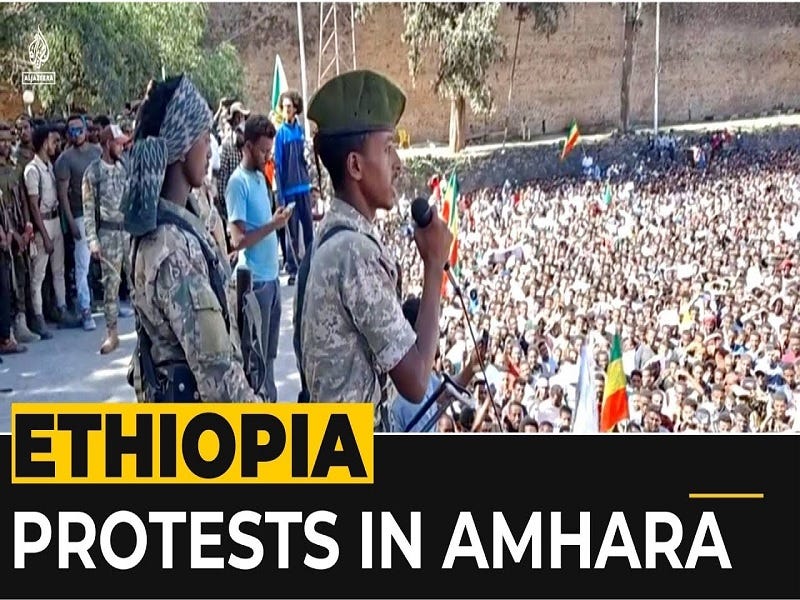Extremely Sensitive Differences Of Perception Are Responsible For Ethiopia's Amhara Protests
Acknowledging these contrasting narratives doesn’t automatically extend credence to them, but simply explains how explosive the latest controversy over that region’s military reorganization is becoming.
Ethiopia’s Amhara Region saw widespread protests in recent days in response to the federal government’s newly announced military reorganization of each region’s special forces. The central authorities claim that this is being carried out around the country in order to strengthen the national army, while a critical mass of Amhara’s residents believe that it’s either only being enforced on their own region’s special forces and/or risks making civilians vulnerable to ethnically driven attacks afterwards.
The larger context in which this is unfolding concerns the country’s post-war rehabilitation after November’s peace agreement with the TPLF ended two years of very fierce conflict. During that time, some preexisting identity differences between this civilization-state’s diverse people were brought back to the fore of national attention, especially issues concerning the Amhara. Some of them claim parts of the Tigray Region, and they’ve also recently been victimized by a spree of ethnically driven attacks.
These two preceding perceptions as well as the earlier one regarding the allegation that only the Amhara Region’s special forces are being reorganized right now are extremely sensitive in and of themselves, but they take on an even greater sensitivity when viewed from the perspective of some non-Amhara. A popular narrative that persists among some elements of society is that this group has historically been privileged and that certain forces among them allegedly pine to restore their leading role in the country.
Those who subscribe to these views might interpret the latest protests in the Amhara Region as a political power play vis-à-vis the federal government, which could in turn heighten the so-called “threat perception” that some non-Amhara have of nationalist forces in that part of Ethiopia. Acknowledging these contrasting narratives doesn’t automatically extend credence to them, but simply explains how explosive the latest controversy over that region’s military reorganization is becoming.
The federal government is therefore placed in a dilemma. On the one hand, continuing to enforce their planned military reorganization of the Amhara Region’s special forces could lead to more large-scale protests and even an insurgency in the worst-case scenario. On the other hand, however, backing down on these plans could further exacerbate the earlier mentioned “threat perception” that some non-Amhara have of nationalist forces in that part of Ethiopia and possibly prompt their own hybrid unrest.
The security situation throughout the country remains fragile due to some preexisting identity differences between its diverse people returning to the fore of national attention over the past two years, especially with respect to Amhara-Tigray and Amhara-Oromo tensions. These factors then blended with the contrasting victimization narratives of some Amhara and non-Amhara, which contributed to the rapid rate at which trust between them has broken down.
Further complicating matters is the powerful role of diaspora influence/interest networks in shaping the discourse of certain ethnic groups and/or the nation as a whole, some of which have goals that are incompatible with one another and/or with the federal government at this point in time. Mutual suspicions have predictably spiked, which is attributable to a combination of disinformation and ineffectively articulated policies that confused a lot of people, thus making them react out of fear.
It's unclear where everything is headed, but responsible stakeholders at home and their sincere supporters abroad (irrespective of whether they’re part of the diaspora or not) should hope that the situation de-escalates as soon as possible. It’s impossible for any solution amidst this complex confluence of interests to satisfy every party’s political demands, but the best that can happen is for stability to return as soon as possible in a way that credibly ensures everyone’s security.
For that to happen, there needs to be a restoration of trust between the federal government and those critical mass of protesters in the Amhara Region, after which they must be careful not to inadvertently worsen the “threat perception” of non-Amhara groups. This is a purely internal matter for the Ethiopian people to resolve themselves without any foreign meddling, which can be advanced by relevant representatives urgently meeting to work out their extremely sensitive differences of perception.


